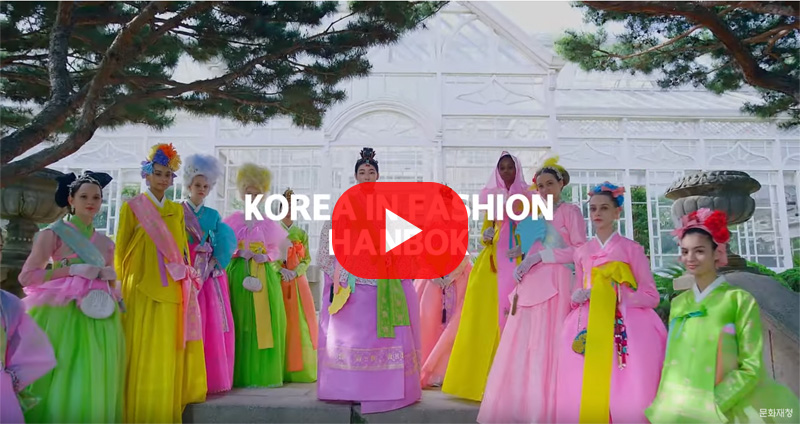Korean traditional Hanbok clothes, expressing linear beauty
Hanbok has been changing its shapes and structures in various ways depending on the lifestyle, culture, circumstances, and aesthetic sense of the time, but keeping the basic configuration for about 5,000 years, acting as the unique ethnic clothing of Korea. The present Hanbok basically retains the shapes and structures popular in the mid and late Joseon period. The upper garment is designed to be slim and the lower garment is generously sized.
Hanbok consists of an upper garment and a lower garment. The basic set for men includes trousers, jacket, vest, and an overcoat. Accessories include belts and ankle bands to tighten the trousers, socks, and shoes. The basic set for women includes underpants, underskirts, outer skirts, undershirts, jacket, overcoat, socks, and shoes. Accessories include Norigae (pendant-like ornaments), rings, and chignon ornaments.
While the structure of Hanbok is very simple, using straight and flat patterns, the method to fold the margins and seams is specified per piece. Moreover, collars, bottom hems, and inseams are designed with curves, rather than straight lines. The wearing method for wearing Hanbok is also specified. Hanbok is generously sized, so it is easy to move and cover various body shapes.
While Hanbok is designed using a flat pattern unlike clothing in western countries, which is designed to fit to a 3D figure, Hanbok changes to fit to the body shape of the wearer, as if it was designed specifically for that person. In other words, the appearance of Hanbok changes depending on the body shape of the person and how they wear it. Hanbok makes a smooth and a beautiful flowing line with the body shape of a person. Such a flowing line highlights both the appearance of Hanbok and the person who wears it. That flowing line is one of the figurative beauties of Hanbok. Moreover, Hanbok is worn in layers from inner garments to outer garments. The natural full-flowing garment, without any artificial beauty, creates unique lines along the body shape of the person who wears it.
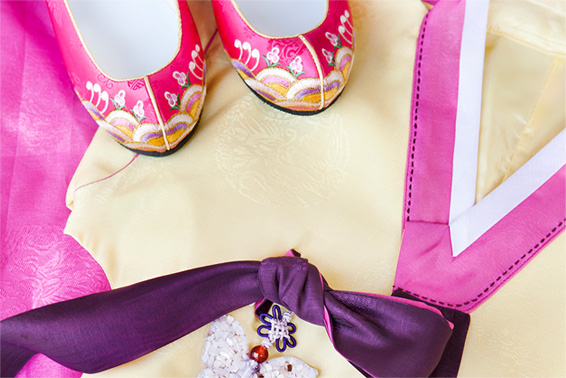
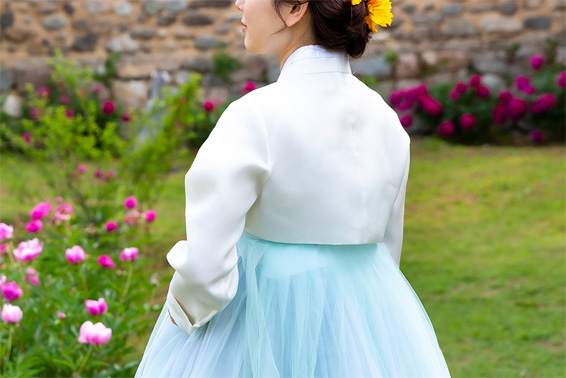

Hanbok is designed with the same pattern creating various shapes depending on fabrics, colors, or sewing method. Hanbok is made with a wide range of fabrics depending on the weaving method with silk and cotton as the common fabrics. Gloss and texture vary depending on the fabric, so diverse kinds of fabrics make varying garments, even when using the same pattern. Dyeing materials from nature create various color senses, including thick or thin colors, bright or dark colors, and clear or turbid colors, depending on the materials and dyeing method.
The fabrics of various colors enrich Hanbok. Furthermore, Hanbok uses different fabrics depending on the season. Accordingly, the sewing methods are changed to fit to the features of each fabric. As a result, the silhouette of Hanbok is diversified per season.
The appearance of Hanbok varies by the sewing methods. Thus, the sewing lines and the sewing method are very important. Hanbok can be made in various shapes depending on fabrics, colors, and sewing method, Due to this various silhouettes of Hanbok can be created.
The harmony of texture of fabric, colors, and sewing lines is the base for creating the unique beautiful lines of Hanbok. When someone wears it, the perfect silhouette is formed and comes to life.
In addition, each element of Hanbok contains diverse meaning, including consideration (courtesy) for others and a desperate wish for life. Hanbok also embrace the spirit of Koreans, including aesthetic awareness, and the philosophy of life.
Being simple but various and plane, yet having dimension and aesthetic awareness, and profound meaning, Hanbok is the ethnic clothing of Korea, which abides by formality, while enhancing beauty and dignity inside and out.
The time of Koreans, up to now contains everything related to life, including clothing, food, and housing. Of them, clothing significantly helps to understand the identify of Koreans and the circumstances of their times. It seems that Koreans produced fabric and made clothing from the Neolithic Age as spindle whorls, bone needles, and linen threads have been found in the historic sites from Neolithic Times. However, the exact time period can only be estimated.
The clothing of Koreans differs per age, gender, and situation of a person from birth to death. When a baby is born, he/she wears a white long shirt for longevity the prevention of diseases. When a baby reaches 100 days old, he/she wears clothing made with 100 pieces of fabric or a quilted jacket with 100 lines, wishing for no troubles in his/her life. When a baby reaches one year of age, he/she wears one-year clothing characterized by sleeves with multicolored stripes. People wish for good luck and health using colors and patterns on clothing.
Koreans wear the brilliant and solemn clothing for weddings, one of the most important ceremonies in one’s life. Wedding costumes contain good wishes including health and happiness for the bride and the bridegroom. The bridegroom wears a round collar robe and a silk winged hat. The bride wears Hwarot (wedding overcoat) embroidered with patterns wishing the couple to live long together. The patterns include lotus flowers, peonies, and a child. The bride also wears a ceremonial coronet or Wonsam (ceremonial robe), and a bridal crown.
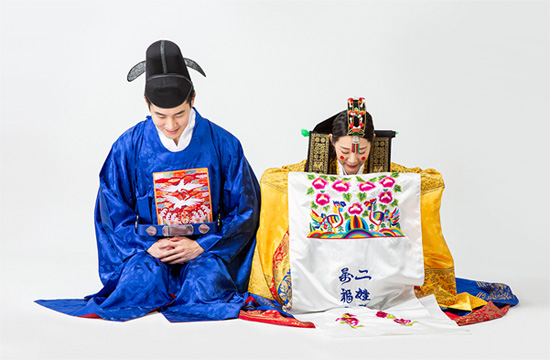
Wedding Garments
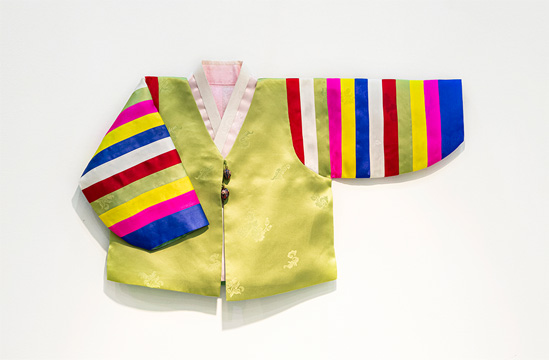
jackets with sleeves of multicolored stripes
When a person reaches their 61st birthday with his/her parents alive, he/she wears a multicolored outer coat, sleeveless coat, and a soft scarf-like headpiece, similar to one worn on the first birthday, and meets his/her parents. For funerals, Koreans wear white mourning clothes with a simple shape to express their sorrow and respect for the deceased. For the ancestral rites, Koreans wear simple clothing with white or jade colors to express reverence for their ancestors.
Clothing implies wish of Koreans for a better life from birth to death and the effort to find happiness living in harmony with others.





